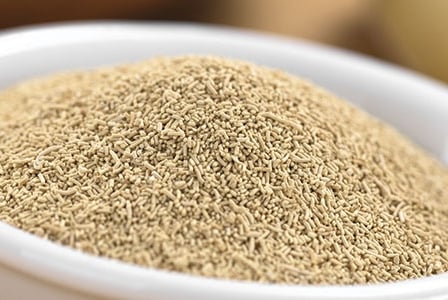
They\’re hidden in many foods and drinks, such as bread, baked goods, and beer. Learn about the different varieties of edible yeast.
Yeast doesn’t have the most enviable of reputations, as some strains of yeast are associated with a number of uncomfortable conditions. However, a number of yeasts are edible and helpful to the body. These yeasts are called food-grade yeasts, and they’re found in everything from beer to doughy pretzels.
What is yeast?
Yeasts are single-celled fungi that are classified as either obligately aerobic (require oxygen) or facultatively fermentative (do not require oxygen). The most commonly known food-grade yeasts are fermentative—meaning they convert sugar into carbon dioxide—and are used in making bread, beer, and wine.
Despite their less-than-appealing description, food-grade yeasts are generally packed with vitamins, minerals, and even protein. Plus, they add distinct flavour and depth to whatever they’re used for—seasoning and cooking included.
It’s time we give yeast, or at least food-grade yeasts, some credit, because even single-celled fungi have feelings.
Nutritional yeast
When I say the words nutritional and yeast together in a sentence, I often get the same response: “Gross.” For people who have not enjoyed nutritional yeast’s cheesy, savoury flavour, I can understand why—it sounds terribly yucky. Poor nutritional yeast!
Primarily sold as a foodstuff item, nutritional yeast is a deactivated Saccharomyces cerevisiae yeast with no leavening power. Some varieties are grown on blends of cane and beet molasses—this is called the fermentation process. After this the yeast is separated, cooled, pasteurized, dried, and turned into flakes for packaging.
It has a yellowy colour and a flaky texture, but dissolves in liquid. It’s a staple in vegan diets, as it gives cheesy flavour to dishes. Many vegan “cheese” sauces, such as for the classic mac and cheese, contain nutritional yeast. But nutritional yeast’s use doesn’t stop at sauces; it can be added to tofu scrambles, creamy dips, casseroles, kale chips, and more.
Nutritional data of this tasty yeast depend on the brand; however, one popular brand fortifies its nutritional yeast with B-complex vitamins and contains 50 percent protein by weight. Some is even fortified with vitamin B12 (read the package to be sure), making this type of yeast ideal for vegans and vegetarians who may have a harder time getting these nutrients.
Nutritional yeast is available in powder or flake form, under several different brand names. It can be found prepackaged or in the bulk aisles of many health food stores. Some stores may also carry nutritional yeast in capsule form, for those who want the health benefits but do not like the taste.
Brewer’s yeast
Brewer’s yeast is made from strains of Saccharomyces cerevisiae that are chosen for their alcohol-producing abilities. When active brewer’s yeast interacts with sugars (such as those found in barley), it ferments the sugars to create alcohol, making brewer’s yeast a necessity in beer making.
In addition to its role in brewing, this yeast is also used as a nutritional supplement, as it is rich in vitamins and minerals. Brewer’s yeast is particularly high in chromium, a trace mineral used by the body to enhance insulin’s effectiveness. It also appears to be involved in metabolizing carbs, fats, and proteins.
As well, brewer’s yeast typically contains notable levels of B vitamins, such as B1, B2, B3, B5, B6, B7, and B9. Brewer’s yeast does not, however, contain vitamin B12, a vitamin found in meat and dairy products. This is important to note for vegetarians, who sometimes mistakenly take brewer’s yeast as a means to up their B12 intake.
Brewer’s yeast is available in powder, flake, tablet, and liquid forms.
Baker’s yeast
Although baker’s yeast is an active yeast and should not be eaten without baking first, the centuries-old importance of baker’s yeast means it can’t be left out of the discussion.
Between the years 1927 and 2008, 165 inventions on 337 baker’s yeast strains were patented. Each new variety boasted higher gassing power, better survival rates when dried, and even antimolding properties, among other things. Who knew yeast was such a science?
Baker’s yeast is also made from combinations of different strains of the fungus Saccharomyces cerevisiae. The strains are chosen for their flavour and ability to create carbon dioxide, which causes bread to rise and have a fluffy texture when cooked.
From a nutritional standpoint, baker’s yeast is high in B vitamins and zinc. Dry active yeast is the most common baker’s yeast. Store opened yeast in the refrigerator away from moisture and heat, which will spoil it. To ensure your baker’s yeast is still active, put a little bit in a bowl with a small amount of flour or sugar and then add a bit of warm water; if it foams within five to 10 minutes, it’s still active.
Torula yeast
Of the strain Candida utilis, torula yeast (sometimes referred to as yeast extract) is also classified as a food-grade yeast, and is often found added to foods to add texture and for its emulsification and flavour-enhancement properties.
There is some question as to whether torula yeast as an additive is good for us, and according to some resources, when sodium and the free glutamate found in torula yeast combine, MSG can form. There is little evidence available to support this; however, if you are trying to avoid additives in your diet, you may want to keep an eye out for torula yeast and yeast extract in ingredient lists.
Yeast may have gotten a bad rap, due to some strains’ tendency to make us sick. But when given the chance, many varieties of food-grade yeasts can be beneficial to our health. And without yeasts such as brewer’s and baker’s we’d be without wine for toasting and bread for breaking. a Does yeast beget yeast?
There is some concern as to whether consuming food-grade yeasts can contribute to vaginal yeast infections or oral thrush. It’s important to note, however, that these infections are caused by the yeast strain Candida albicans, and therefore are unlikely to be aggravated by food-grade yeasts.
Some believe that sugars, such as those found in beer and bread, may trigger candida; however, this is not backed by scientific evidence. If you are experiencing problems with candida, discuss it with a health care practitioner.
Yeast varieties: fast facts
| Type of yeast | Strain | Used for | Nutrition highlights | Identifying features | Available forms |
| baker’s yeast | Saccharomyces cerevisiae (active) | baking bread, other baking requiring rising | B vitamins, zinc | small granules, smells like rising bread dough | individual packets, jars |
| brewer’s yeast | Saccharomyces cerevisiae (active or inactive, depending on the type) | making beer, nutritional supplementation | B vitamins, chromium | tan-coloured | powder, granules, tablets, or capsules |
| nutritional yeast | Saccharomyces cerevisiae (deactivated) | cooking; adds a cheese flavour to dishes | B vitamins, protein | yellow, cheesy flavour | flakes, powder; sometimes sold under the name Engevita yeast |
| torula yeast | Candida utilis (deactivated) | added to food for flavour | vitamin B2, iron | may combine with sodium to form MSG | added to foods, sometimes called yeast extract |







